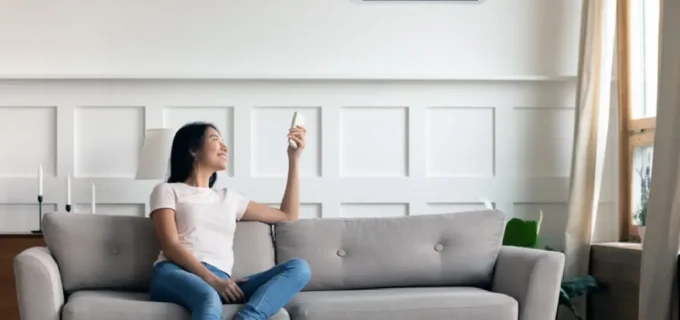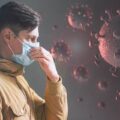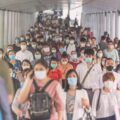The Compelling Scientific Date that Proves the Virus is in the Air We Breathe
Since the Coronavirus (COVID-19) pandemic began in December 2019 it has now spread around the entire world, giving the scientists in every country the opportunity to study and test its aetiology or in simple terms its means and modes of transmission, as in order to control its spread, you first need to understand precisely how it is transmitted.
Now after almost a year of in-depth study and analysis the scientific data have converged to provide an unequivocal picture of how the COVID-19 virus is spread and it is now clear that the primary route of infection is from viral material that has become airborne. The scientific data has also indicated that the vast majority of airborne transmission occurs in crowded and inadequately ventilated spaces whether in buildings, trains, buses, or airplanes. Now that the scientists have determined how the virus spreads, we now need to use this data to guide our infection control interventions.
The Role of Air Conditioning in Mitigating the Risk of COVID-19 Transmission

When COVID-19 positive individuals (not wearing a mask) cough, sneeze talk, shout or sing they will, quite naturally expel very large numbers of droplets into the air. These airborne droplets will vary in size. Some will be tiny microscopic droplets that are completely invisible whilst some will be much larger and easily visible to the naked eye. Irrespective of the size of the droplets, all droplets expelled by a COVID-19 positive person that is actively shedding infectious viral particles will be highly contagious.
The larger, visible airborne droplets carrying their contagious viral load will fall due to gravity and deposit the infectious viral material onto surfaces or objects immediately causing them to become potentially infectious. Conversely, the much smaller droplets that are microscopic in size will almost immediately have the aqueous component evaporate leaving only the incredibly small particles of infectious viral material floating in the air.

Because of their extremely small size, viral particles have been demonstrated to remain suspended on indoor air currents for extended periods of time that can be measured in hours and days rather than minutes. Once airborne, viral particulate material is also readily inhaled deep into the mucous membranes lining the respiratory tracts of other people causing infection.
In light of the compelling scientific evidence confirming that the contagion of COVID-19 is exacerbated by confined, crowded, and poorly ventilated spaces, it becomes abundantly clear that we must, as a matter of course begin to pay greater attention to indoor air quality and how it should be incorporated into COVID-19 infection control measures.
Optimising HVAC and Air Conditioning Systems to Mitigate Viral Transmission

If we accept the logical premise that COVID-19 is transmitted more frequently indoors, where air doesn’t move as much or as quickly as it does outdoors, it is a logical thought progression that we can actually use air conditioning to attenuate, rather than to exacerbate the spread and transmission of infectious viral particles. The overall approach is relatively simple; and is based on extracting and ejecting potentially infectious viral particles suspended in indoor air to the outside and also arresting, trapping, and destroying viral particles and thereby preventing their recirculation within indoor air. There are three main approaches that can be adopted:
Hard Technologies and Engineering Control
Within this approach there are two things that need to be accomplished and the two should NOT be considered mutually exclusive, both need to be implemented.
- Increasing the Volume – The number of hourly air exchanges should be increased because simply extracting the potentially contaminated air inside the building and removing it to the outside will effectively dilute the airborne viral load within the confined space in question. This concept is not new and has already been effectively deployed in specialist environments such as healthcare and ‘high-tech clean-room’ facilities. Of course, moving larger volumes of air calls for a combination of larger fans, higher fan speeds, and extended running periods.
- Enhanced Filtration – In addition to increasing the volume of the air passing through the air conditioning units, the efficacy of the air filtration can also be enhanced by upgrading the filtration medium from standard specification to High-Efficiency Particulate Air (HEPA) filters. These filters are capable of arresting and capturing all particulate matter, including viral material within the fabric of the filter medium.
- Ultraviolet (UV) Technologies – Ultraviolet light is a well-tried and tested technology for killing all types of microbes either from the air, suspended in water or present on objects or surfaces. Ultraviolet light at a wavelength of 254 nanometres which is also known as UV-C can kill bacteria and some larger viruses. However, to assure efficacy against COVID-19 a shorter wavelength of UV is required known as ‘Far UV-C’. Whilst this technology is already proven to be effective under laboratory conditions, the knowledge on placing the equipment and the light intensities required to kill airborne COVID-19 particles is currently unarticulated.

Antimicrobial Disinfectants and Surface Treatments
If we can try to imagine millions of potentially infectious COVID-19 viral particles suspended in the air and then being drawn into air conditioning units through vents, ducts and filters, it makes good sense to eliminate this potentially infectious viral load wherever possible. The recommended procedure for eradicating and subsequently maintaining low viral loadings of COVID-19 can be achieved in a simple two-step process:
- Instant Kill and Viral Eradication – If there is any concern at all about whether or not COVID-19 viral particles might be present within an air conditioning system, then, of course, the most prudent course of action is to immediately kill and eradicate all traces of the virus without delay. This can be achieved in a number of ways: the most traditional method is to clean and sanitize all the surfaces concerned and then spray with a solution of sodium hypochlorite (bleach). However, this is labor-intensive, time-consuming and it is very difficult to reach every nook and cranny with a simple spray. A much more effective approach is to use an electrostatically charged nebulized solution of Hydrogen Peroxide. This methodology achieves the highest possible viricidal kill rates and in the hands of a professional and suitably qualified cleaning and disinfection specialist, can be accomplished in a very short period of time.
- Long Term Antimicrobial Disinfection – Once the presence of the virus has been completely eliminated from the air conditioning system and the immediate surroundings, the next strategy is to ensure that any new incoming infectious COVID-19 particles are effectively rendered ‘dead on arrival’. This requires the use of a long-term antimicrobial surface coating such as an organo-silane based non-leaching compound. Once applied to a clean surface, whether a hard surface or a fabric filter medium, these long-term disinfectants are capable of killing in-bound particles of COVID-19 immediately on contact for a period of up to 180 days.
Conclusions
Of course, as with many things in life, the best policy here is an integrated holistic approach and an appropriate blend of the solutions outlined above will yield a much greater degree of protection than selecting a single approach.
Related Posts
- Mitigating the Risk of Coronavirus Infection with the Best Housekeeping Protocols
- How to Leave Coronavirus Behind When You Come Home
- Coronavirus – Protecting Your Indoor Surface
- The Airborne Covid-19 Threat and What We Can Do About It




